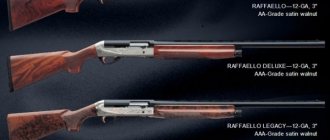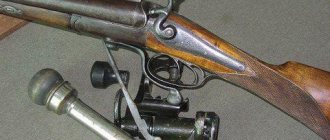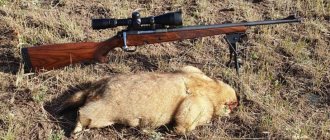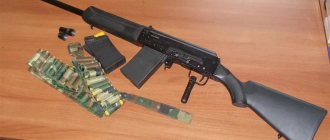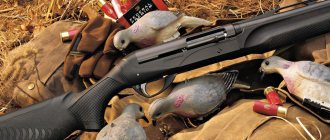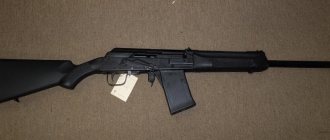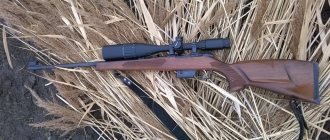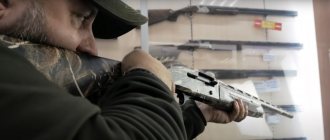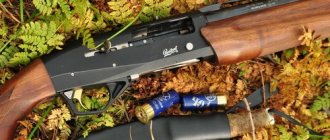We know how difficult it can be to choose a gun for hunting, especially if you are just starting to dive into the exciting world of a new hobby. There are many models of hunting weapons in our assortment, but the most versatile are 12-gauge semi-automatic shotguns. They allow you to become a full participant in almost any hunt and help you catch any game from woodcock and duck to elk or wild boar. To help you make your choice, we present seven models of reliable and useful Italian semi-automatic machines in the price range from 70 to 150 thousand rubles. At the end of the article there is a comparative video review of all guns. Watch and make your choice!
Elite Italian hunting rifles: characteristic differences and popular brands
“Hand Cannon” RT-20 14.5 mm anti-tank rifles PTRD and PTRS 4.2-line rifle of the Berdan system 7.62 mm Tokarev self-loading rifle of the 1940 model SVT-40 7.62 mm Simonov self-loading carbine of the 1945 model (SKS-45) Brown Bess Bekas-12M Auto Combat smoothbore gun IZH-81 Rifle M1903 Springfield Mosin rifle Choosing a gun Choosing a safe for an IZH-12 gun History of the rifle How to join a hunting society?
How to choose a weapon for hunting Carbine "Vepr-Hunter" Carbine Mauser 03 Trail Modernization and tuning of the Simonov self-loading carbine Musket Hunting weapon of the 3rd millennium (MC 19) Hunting weapon for a beginner: which option is better? The first shotgun Pishchal Shotguns Vincenzo Bernardelli Self-loading hunting carbine "Tiger-9" Amazing powder (Gunpowder) Fuzeya Fitting Elite Italian hunting shotguns: characteristic differences and popular brands
Conventionally, all guns, depending on quality characteristics, design and cost, can be divided into several categories:
- Budget options up to $500.
- Quality affordable shotguns under $1,500.
- Elite models of mass production up to $5,000.
- Exclusive, one-off options, the cost of which can range from several thousand to several tens of thousands of dollars.
Let's leave the first two categories and talk about the last two - top-class guns. They can be used for hunting, but are often purchased as collectible weapons, the possession of which already speaks of the owner as a person with impeccable taste and high income.
Among the manufacturers of expensive exclusive goods, Italian arms houses can be especially noted: “Antonio Zoli srl”, Fabbrica d'Armi Pietro Beretta Gardone, Fabarm. Their products have found recognition among many experts: Italian hunting weapons of these brands have become a real synonym for quality.
Italian centenarian
Features of Italian sports
As you know, one of the first PPs in the world was created in Italy, by the Vilar-Perosa company. Its designer was Benedetto A. Revelli. The weapon, which appeared in 1915, was a “spark” of two PP with a record low bolt travel. The weapon was created for the Italian 9x20 mm pistol cartridge Glizenti, which had a slightly higher power than the Parabellum cartridge, and, in addition, a heavier pointed bullet. The stores were located on top, high bipods were attached to the ends of the barrels, and dual machine-gun handles were attached to the butt plates of the receivers for fire control with separate triggers, much like on the easel Maxim. In addition to being terribly bulky and heavy, the Vilar-Perosa SMG had an extremely low target range and a rate of fire of more than 2000 rounds per minute. With such a bouquet of “advantages”, this either a machine gun or a carbine, naturally, could not cause anything but criticism. But soon after the end of the First World War, this type of PP served as the basis for a unique weapon of its kind - a “sports” submachine gun!
Revelli submachine gun, mod. 1915
In the early 20s, B. Revelli designed a lightweight carbine based on the “half” of the Vilar-Perosa PP. Having retained the main components of its ancestor, the new weapon, which received the OVP index, received a longer barrel, the handle with trigger, unacceptable for a hand weapon, gave way to a normal trigger mechanism and a convenient wooden butt with a neck mounted behind the butt plate of the receiver. The store was still attached to the top; the sighting device for firing at a fixed distance of 100 m was shifted from the axis of the weapon to the left. The undoubted advantages of the weapon include the presence of a fire selector made in the form of two tandem triggers, because in automatic mode the OVP rate of fire exceeded 1100 rounds/min! In addition, the PP was prohibitively long and rather poorly balanced. But at the same time, it is refined and elegant in Italian.
At first, the Italian army did not show much interest in the new model - the war was over, and, as always, there were not enough funds for defense. But after Benito Mussolini came to power, the Vilar-Perosa company received a huge order for OVP, which began to be supplied en masse to the police, army, as well as to civilian and party organizations of initial military training. There it was used (according to official data) as... a sports PP. I wonder what sports and shooting disciplines could be held in competitions using automatic weapons?
One way or another, in total, about 180 thousand OVPs were produced for the army, police and the Italian analogue of DOSAAF, which by the beginning of the Second World War were already obsolete weapons. However, a number of these SMGs entered service with Hungary, Romania, Bulgaria and Finland. True, no data has been found on the use of this weapon in combat.
Weapons for the Carabinieri
When listing the leading European manufacturers of small arms, the company Pietro Beretta is usually named among the first. In the years preceding the Second World War, its designers created several very successful and reliable models, which were in service not only in Italy, but also in the Axis allied countries.
ORP submachine gun
Beretta submachine gun, M1918-30
Beretta submachine gun, M1938A
Beretta submachine gun, M38/42
Even during the First World War, in 1916-1918. Beretta gunsmith Tomaso Marengoni created a very compact lightweight M1918 carbine chambered for the Glisenti cartridge. Externally, its shape repeated the Mannlicher-Carcano carbine adopted by the Italian army and police, which made retraining easier. Like the prototype, the Marengoni carbine had a reversible triangular bayonet. The bolt was semi-free, at the initial moment of the shot it was fixed in the forward position by turning at a small angle around the longitudinal axis. However, the rate of fire was too high - about 900 rounds per minute, which was due to the short length of the bolt box and the relatively high power of the cartridge. There was no fire selector - it was considered that its introduction into the design would unacceptably complicate it. But the experience of combat use showed that a 25-cartridge horn is consumed within a matter of seconds, so a self-loading carbine, which was no different in appearance from the first version, began to be produced for carabinieri and police.
The only drawback of the M1918 was the upper location of the magazine, which negatively affected the balancing of the weapon. In 1930, the carbine was modified - the magazine neck was moved down, and the bolt box was slightly lengthened. The updated weapon received a sector sight for firing at a range of up to 500 m. Its index was changed to M1918-30. In this form, the weapon was used to a limited extent in the Second World War - in particular, in Africa and Ukraine. After the war, the M1918-30 in a self-loading version continued to be produced as an initial training weapon and a sports carbine.
Folgore Division paratroopers emerged from the dugout, probably at Alamein. Most are armed with Mannlicher-Carcano M1891 or 91/38 flip-bayonet carbines, one with a Beretta M1938A
Italian centenarian
The impending world war required the creation of a more serious PP, without any pretense of military weapons - with appropriate reliability, as well as combat and operational characteristics. In 1936-38 Beretta created such a PP, which received the index M1938A.
It was a rather massive and heavy weapon with a wooden butt and a long stock. The barrel was covered with a casing. There was an effective compensator on the muzzle of the barrel. Tandem triggers, which have become traditional for the Italians, were used as a fire selector - the front one for single fire and the rear one for continuous fire. Ammunition was supplied from simple stamped box magazines with a capacity of 20 or 40 rounds. The only step back was the use of the low-power Browning 9-mm cartridge 9M1938, which, however, somewhat reduced the rate of fire and did not lead to a loss in range and destructive power thanks to the long barrel and well-calculated internal ballistics. The sector sight was notched at a range of up to 300 meters. The PP had two safeties - a sliding “knob” on the cocking handle, which made it possible to fix the bolt in the forward position, and a safety lever on the left side of the butt neck.
Made of good steel, extremely reliable and comfortable to shoot, the Beretta M1938A was widely used both during and after World War II. Its serial production was stopped only in the 1950s. due to the transition to much more advanced models.
As in any other warring country, in Italy the question of improving the technological qualities of such a mass product as army PP was raised with all seriousness. T. Marengoni, who by 1940 became the chief designer of the Beretta company, took on the creation of such a model, clearly under the influence of Volmer's MP-40. The new weapon, put into service at the end of 1940 and called “Beretta I,” although it was, in fact, a deep modification of the previous model, had much in common with its German counterpart. Even in appearance they were similar - the Beretta I had a bare barrel, a folding butt, and a beveled pistol grip. The 9×18 Parabellum cartridge was used for shooting. True, the design included such improvements as a fire selector (tandem triggers), two fuses, as on the previous model, a muzzle compensator, as well as a slot in the bolt box for the cocking handle, reduced to the required minimum. Regarding the MP-40, the assembly and disassembly procedure has been simplified. The disadvantages of the system include its large mass, an overly simplified sighting device, which allowed firing only at a distance of 100 m (and on the other hand, more was rarely required), as well as the inability to expand and fold the rotating shoulder rest with an attached magazine.
The Beretta I SMG was produced in relatively small quantities - about 2000 copies - and was in service with the Italian airborne troops. But as in the case of the MP-40, on the basis of which the heavier MP-41 was developed, the Beretta I was modernized, creating a version for the army. Technically, the differences were small - a wooden stationary stock with a neck, a barrel with longitudinal milled ribs for better cooling and a shortened magazine neck - but purely externally the PP began to look more solid. Mass production of the army model, named M38/42, once again emphasizing the continuity with the M1938A, was launched in 1944, but the peak of production occurred in the post-war years - the M38/42, produced in three slightly different modifications, became widespread in some countries in Europe, as well as in Southeast Asia and Latin America.
Zoli
The combination of ergonomics and stylish design is the hallmark of products from Antonio Zoli srl. The philosophy of the gun house follows the idea that there are no trifles in the manufacture of guns: every detail of the design plays a huge role, and therefore must be carefully thought out. All components are produced in Antonio Zoli's own factory. and “before” controls the release process, offers for sale only goods of the highest category.
The most popular models are Zoli Kronos Black Sporting Agj, Zoli Columbus, Zoli GC Expert. Their prices range on average from $2,000 to $5,000.
Beretta
When Italians talk about classic weapons, they often mean Beretta brand products. The history of Fabbrica d'Armi Pietro Beretta Gardone dates back to the 16th century. Today it is one of the oldest enterprises in all of Italy.
Products under the Beretta brand are examples of reliability and durability. The company offers products in several price categories - from high-quality mass-produced weapons to exclusive samples. For example, Beretta A400 Xplor Novator kick-off, Beretta A400 Xplor Action, Beretta 686 Silver Pigeon costing up to $3,000, as well as Beretta DT11 Sport and Beretta 687 EELL Diamond Pigeon, which cost more than $7,000.
Fabarm
The Fabarm company specializes in the production of not only hunting, but also small arms intended for defense and for use in various law enforcement agencies. Almost every year the brand pleases its fans by introducing new models to the market. Practical and modern Fabarm shotguns are suitable for true connoisseurs of quality weapons.
The manufacturer offers:
- Available models - Fabarm SDASS Composite, Fabarm SDASS Tactical, etc. (cost up to $1,500).
- Premium products - Fabarm Elos, Fabarm Hunter, etc. up to $2000.
Watch a video review of popular Italian semi-automatic shotguns
For more information about Italian semi-automatic shotguns in the price range from 70 to 150 thousand rubles, see our new video. In it, hunting department expert Sergei Pisarev and popular hunter blogger Yarik Andersson openly talked about the characteristics and mentioned the advantages and disadvantages of each model. According to established tradition, we tested the ergonomics of these guns blindly. Everything so that you can make an informed choice when you come to the store to buy a new gun and enjoy your hunts.
To solve your shooting problems, a huge assortment of hunting weapons for every taste and budget is available in the World of Hunting chain stores. We have smoothbore guns, rifled carbines (including small-caliber ones), and pneumatics from Russian and foreign manufacturers. Come and make your choice!
The reference article is based on the expert opinion of the author
